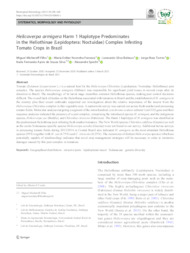Helicoverpa armigera Harm 1 Haplotype Predominates in the Heliothinae (Lepidoptera: Noctuidae) Complex Infesting Tomato Crops in Brazil.
Helicoverpa armigera Harm 1 Haplotype Predominates in the Heliothinae (Lepidoptera: Noctuidae) Complex Infesting Tomato Crops in Brazil.
Author(s): MICHEREFF-FILHO, M.; FONSECA, M. E. N.; BOITEUX, L. S.; TORRES, J. B.; SOUZA SILVA, K. F. A. de; SPECHT, A.
Summary: Abstract Tomato (Solanum lycopersicum L.) is a natural host for the Helicoverpa-Chloridea (Lepidoptera: Noctuidae: Heliothinae) pest complex. The species Helicoverpa armigera (Hübner) was responsible for significant yield losses in several crops after its detection in Brazil. The morphology of its larval stage resembles common Heliothinae species, making pest control decisions difficult. The overall lack of studies on the Heliothinae associated with tomatoes in Brazil and the establishment of H. armigera in the country plus their recent outbreaks supported our investigation about the relative importance of the insects from the Helicoverpa-Chloridea complex in this vegetable crop. A nationwide survey was carried out across fresh-market and processing tomato fields. Molecular analyses targeting a segment of the mitochondrial cytochrome oxidase subunit I (mtCOI) gene and their sequence analyses indicated the presence of a pest complex, comprising the introduced species H. armigera and the indigenous species, Helicoverpa zea (Boddie), and Chloridea virescens (Fabricius). The Harm 1 haplotype of H. armigera was identified as the predominant Heliothinae pest infesting fresh-market tomatoes. The New World species Chloridea subflexa (Guenée) as well as the exotic Solanaceae-specific species Helicoverpa assulta (Guenée) were not found in our survey. Additional larvae surveys in processing tomato fields during 2013/2014 in Central Brazil also indicated H. armigera as the most abundant Heliothinae species (95%) together with H. zea (4.75%) and C. virescens (0.25%). The occurrence of distinct Helicoverpa species (which are potentially capable of interbreeding) indicates that novel crop management strategies will be necessary in order to minimize damages caused by this pest complex in tomatoes.
Publication year: 2021
Types of publication: Journal article
Unit: Embrapa Cerrados
Observation
Some of Embrapa's publications are published as ePub files. To read them, use or download one of the following free software options to your computer or mobile device. Android: Google Play Books; IOS: iBooks; Windows and Linux: Calibre.
Access other publications
Access the Agricultural Research Database (BDPA) to consult Embrapa's full library collection and records.
Visit Embrapa Bookstore to purchase books and other publications sold by Embrapa.

